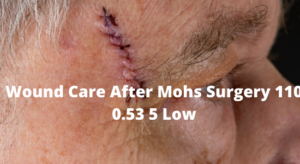It would be best to choose an efficient wound care center in Chicago that gives the best care for patients and unbelievable services after Mohs surgery. As Mohs surgery takes more time to heal, you should be careful after this surgery.

What is Mohs?
It is a precision operation used to cure skin cancer. The cancerous skin is removed in tiny layers and evaluated under a microscope until only healthy skin remains. Mohs Surgery is the primary treatment for skin cancer on the face, neck, hands, and feet. It is also routinely used for other aggressive or extensive skin tumors. A Mohs surgeon’s primary goal is to remove all skin cancer while sparing healthy surrounding tissue.
Which methods of skin cancer removal are better than Mohs?
Mohs surgery is the gold standard for skin cancer eradication, with a cure rate of around 99 percent for many lesions.
- Others remove or destroy considerable portions of normal tissue around the skin cancer.
- Mohs surgery leaves the smallest surgical hole possible because the normal skin is removed.
- Other skin cancer removal techniques leave larger sores that require more extensive healing.
- More minor wounds with Mohs surgery mean less complicated surgical repairs and a better cosmetic outcome.
- Other cancer removal methods may require a patient to undergo general anesthesia, which carries considerable risks.
- The Mohs surgery is conducted under local anesthetic, reducing risks, downtime, and problems.
What Can I Expect On Surgery Day?
Mohs surgery goes like this:
- Oncologists remove cancerous tissue with a small perimeter of healthy tissue around the edges and underneath the malignancy.
- The surgeon then microscopically examines the tumor specimen to check that the outer margins and undersurface are cancer-free.
- If any cancer cells are found around the specimen’s edges, more skin tissue is removed and analyzed in the same way.
- After the cancer is removed, the wound can be surgically closed.
How Long Is the Mohs Surgery?
Skin cancer is removed with Mohs surgery under local anesthetic. How to wound care after Mohs surgery?
How does Will My Wound Heal?
Most Mohs surgical wounds can be fixed immediately, and depending on the situation, others can heal without surgery. In rare circumstances, our surgeons may recommend a plastic surgeon for reconstruction. These choices are thoroughly explored with each patient before a shared decision is reached.
High Risk After Mohs Surgery 110 0.53 5 Low
In high-risk lesions, the defect area calculated for SE is 5,44 fold the defect size calculated for MMS. The SE defect size was less than the Mohs defect size to remove 11 out of 94 tumors (11.7%). Three were high risk.
The MMS defect area and predicted SE defect area reveal that MMS did not spare much tissue in low-risk SCC. MMS saved 59 percent more tissue than a SE with pre-determined margins for high-risk lesions. Regardless of the risk degree of the lesions, MMS shows a 52% tissue sparing effect. The defect area post-MMS and the predicted defect area for SE were statistically different in tumors smaller than 1 cm2 and more significant than 1 cm2.
This is the first study to quantify MMS’s tissue sparing characteristics in SCC. Gniadecki et al.7 studied 263 basal cell carcinomas, of which 54% were primary. Using micrographic techniques instead of SE with preset margins reduces the excision area by over 40%.
Muller et al.8 studied 30 nodular BCC tumors with less than 1 cm in diameter clinical diagnostic. These were omitted. Patients were either given MMS or regular surgery. The MMS group’s median area of surgical defects was 116.6 mm2, compared to 187.7 mm2 in the standard surgery group with a 4 mm margin (95 percent CI = 61–126, p.001). Van Kester et al. nine recently completed prospective research on 256 primary BCC lesions to assess MMS’ tissue-sparing characteristics. The 5-mm margin was used to compute the suspected defect surface area. MMS saved 46.4 percent tissue (95 percent confidence interval, 43.4 percent -49.1 percent; P value.001) compared to standard surgical excision.
Wound Care After Mohs Surgery on Nose
In rare circumstances, large Mohs wounds necessitate the aid of another physician. It may be inconvenient to wait between Mohs and reconstructive surgery, but it will not harm you. It is typically required as Mohs surgery might take all day. In addition to written instructions, we will provide verbal explanations from the doctor or nurse and phone numbers (day and night) for inquiries.
Post-Mohs Surgery Recommendations
Pain is usually effectively treated with acetaminophen after Mohs surgery (Tylenol). Significant pain should be reported. Localized edema and bruising may occur three to four days after surgery. This should go away in a week.
If you undergo surgery on your forehead or nose, your eyelids may enlarge, and the swelling and bruising may close them. Swelling and bruising can extend down the neck and infrequently the chest after chin or jawline surgery. During the first 48 hours after Mohs surgery, apply an ice pack for 20 minutes per hour while awake.
A little blood or seepage on the dressing is common following Mohs surgery. If you see active bleeding, remove the bandage and apply firm pressure with dry gauze or a dry towel for 20 minutes. Call the dermatologist or us (after office hours). In rare cases, cauterization may be required to halt the bleeding.
After Mohs surgery, you should avoid strenuous activity, bending over, or exercising for seven days to allow your wound to heal correctly and avoid bleeding or stitch damage. Sutures are typically removed 5-10 days post-op. We will monitor your recovery and determine whether any operations are required.
CONCLUSIONS
In SCC, MMS saved 52% of tissue. The effect on high-risk cancers was more significant. MMS preserved 33% more undamaged skin tissue than SE in lesions >1 cm2 and 69% in tumors 1 cm2.
You can contact our wound care specialist in Chicago, il. For this call at (847)813-6301.
